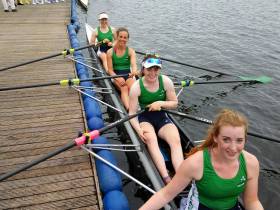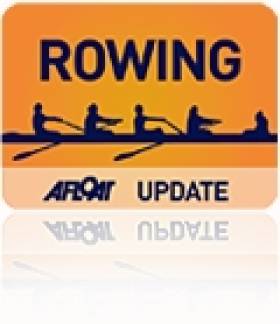Displaying items by tag: Strathclyde
Ireland Lightweight Pairs Win at Home International Rowing
#Rowing: Ireland had two consecutive wins at the Home International Regatta in Strathclyde. The women’s lightweight pair of Gill Crowe and Hazel O’Neill won, and were followed quickly by the men’s lightweight pair of Colm Hennessy and Stephen O’Sullivan. At midday, Ireland’s senior women led the rankings, while England led in the boys’ and girls’ competition and in the senior men’s rankings.
Ireland Senior Team Named For Home International Regatta
#ROWING: The Ireland senior team for the Home International Regatta in Strathclyde in Scotland on July 25th has been named. Justin Ryan, who was a senior Ireland international in 2013, will compete in the lightweight single sculls. The selection was based on performances at Cork Regatta, but the times used were from the manual system, as there were problems with the automatic system. The athlete levy will be €400.
| SENIOR MEN |
|---|
| The following Senior Men have been selected to compete for Rowing Ireland at the |
| Home International |
| Regatta 2015 |
| SENIOR |
| MEN SCULLING |
| 1 |
| x |
| Luke Keating |
| Carlow RC |
| Lwt 1 |
| x |
| Justin Ryan Skibbereen RC |
| 2x |
| Fionnan Groome Commercial RC |
| Ronan Allen Garda BC |
| Lwt 2x |
| Declan O’Connor St Michaels RC |
| Raymond O’Mahony Waterford BC |
| 4x |
| Justin Ryan Skibbereen RC |
| Declan O’Connor St Michaels RC |
| Luke Keating Carlow RC |
| Fionnan Groome Commercial RC |
| SENIOR |
| MEN SWEEP |
| 2 |
| - |
| Neil Gahan Commercial RC |
| Colm Dowling Commercial RC |
| Lwt 2 |
| - |
| TBD |
| 4 |
| - |
| Max Murphy UCD BC |
| Niall Farrell UCD BC |
| Ken McCarthy Skibbereen RC |
| Murray Connolly Skibbereen RC |
| 4+ |
| Andy Harrington UCC RC |
| Alex O’Riordan UCC RC |
| David O’Leary UCC RC |
| Sean O’Sullivan UCC RC |
| Gavin Connolly - Cox Commercial RC |
| 8+ |
| Neil Gahan Commercial RC |
| Colm Dowling Commercial RC |
| Max Murphy UCD BC |
| Niall Farrell UCD BC |
| Ken McCarthy Skibbereen RC |
| Murray Connolly Skibbereen RC |
| Andy Harrington UCC RC |
| Alex O’Riordan UCC RC |
| Gavin Connolly - Cox Commercial RC |
| The crews listed above are not listed in seat order in t |
| he boats |
| Page 2 of 3 |
| SENIOR WOMEN |
| The following Senior Women have been selected to compete for Rowing Ireland at |
| the Home International |
| Regatta 2015 |
| SENIOR |
| WOMEN SCULLING |
| 1 |
| x |
| Julia Vascotto Castleconnell |
| BC |
| Lwt 1 |
| x |
| Sarah Quinn Belfast BC |
| 2x |
| Olivia Blundell Belfast BC |
| Chloe Deyermond MCB RC |
| Lwt 2x |
| Phoebe Mulligan Belfast BC |
| Kirstie Turner Belfast BC |
| 4x |
| Sarah Quinn Belfast BC |
| Phoebe Mulligan Belfast BC |
| Kirstie Turner Belfast BC |
| Julia Vascotto Castleconnell |
| BC |
| The crews listed above are not listed in seat order in t |
| he boats |
| SENIOR |
| WOMEN SWEEP |
| 2 |
| - |
| Michelle Lonergan Shannon RC |
| Helen Ryan Shannon RC |
| Lwt 2 |
| - |
| TBD |
| 4 |
| - |
| Aoife Gilligan Shannon RC |
| Karen Joy Shannon RC |
| Dineka Maguire QUBLBC |
| Aine De Baroid QUBLBC |
| 4+ |
| Anne O’Leary Commercial RC |
| Edel Garry Commercial RC |
| Martina Bracken Commercial RC |
| Emma Feerick Neptune RC |
| Shauna Fitzsimons – Cox Commercial RC |
| 8+ |
| Michelle Lonergan Shannon RC |
| Helen Ryan Shannon RC |
| Anne O’Leary Commercial RC |
| Edel Garry Commercial RC |
| Aoife Gilligan Shannon RC |
| Karen Joy Shannon RC |
| Martina Bracken Commercial RC |
| Emma Feerick Neptune RC |
| Shauna Fitzsimons - Cox Commercial RC |
| The crews listed above are not listed in seat order |
































































